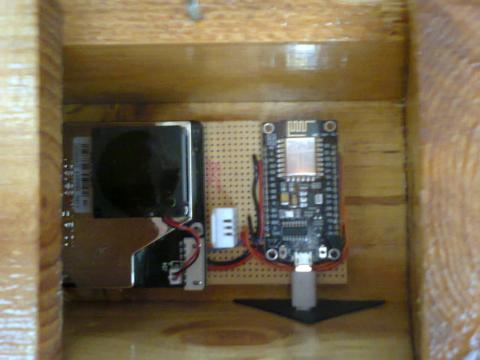
Push Bikes has joined the environmental monitoring citizen science project set up by OK Lab Stuttgart, adding the second measurement node in Birmingham (the first was in Ladywood, but this is no longer operational). Our air quality monitor is in south Birmingham, sheltered from roads. Although the Ladywood measurement node disappeared, a greater number of new nodes have appeared in Birmingham since the Push Bikes node went online, and there are other measurement nodes across the Midlands. As described below, you can relatively easily add your own.
The device measures particulates (such as the smoke you you can see from the exhaust of a badly driven/faulty diesel vehicle), but not, unfortunately, NOx (and we already know that EU NOx limits have been broken at the nearby Selly Oak Triangle junction). The node also measures temperature and humidity.




If you are unfamiliar with how particulates are defined and measured, this Wikipedia article explains the terminology. The EU limits on PM10 and PM2.5 are 40 µgm⁻³ (microgrammes per cubic metre) and 25 µgm⁻³ respectively, averaged over a year (hence the rolling averages in the graphs above are more useful than the measured values), and these set the legal limits in the UK. Before brexit the government claimed it wanted to set a higher standard, namely the limits recommended by the World Health Organisation (WHO), ie annual means of 20 µgm⁻³ and 10 µgm⁻³ respectively for PM10 and PM2.5, and 24 hour means of 50 µgm⁻³ and 25 µgm⁻³. The WHO 24 hour mean can be directly compared with the 24 hour rolling mean graphs shown above. This might seem surprising given that the pre-brexit the government was losing in the law courts because the UK was failing to meet EU standards. So it shouldn't really be any surprise that parliament voted against the proposal. Now that the UK is no longer in the European Union, there are calls from brexiteers to "take advantage" of this to scrap all the consumer, environmental, and worker protections that we inherited from our time as a key member state.
Measurement Nodes in Birmingham
Map showing readings from both official and Sensor Community measurement nodes.
Detailed results in graphical form:
How You Can Contribute
It's pretty easy to make your own sensor if you have access to a PC (Linux or Windows) or a Mac to flash the microcontroller and you can accurately follow step-by-step instructions.
 The Push Bikes sensor deviates from the suggested construction method. Firstly, everything is soldered to strip-board, but if this is not an option for you, using a wooden base-board with sticky pads would be less likely to result in damage than the suggested arrangement. On the subject of damage, the components are static sensitive, so when working with them either wear an anti-static strap, or periodically touch something that is earthed, such as the unpainted parts of a radiator. You wont be able to make the suggested housing in the UK because the relevant pipe fittings, whilst very cheap and easily available in Germany, are not easily obtainable in the UK. So you'll have to improvise; The Push Bikes sensor is housed in a bird box coated with four coats of yacht varnish. The the total cost was about £60.
The Push Bikes sensor deviates from the suggested construction method. Firstly, everything is soldered to strip-board, but if this is not an option for you, using a wooden base-board with sticky pads would be less likely to result in damage than the suggested arrangement. On the subject of damage, the components are static sensitive, so when working with them either wear an anti-static strap, or periodically touch something that is earthed, such as the unpainted parts of a radiator. You wont be able to make the suggested housing in the UK because the relevant pipe fittings, whilst very cheap and easily available in Germany, are not easily obtainable in the UK. So you'll have to improvise; The Push Bikes sensor is housed in a bird box coated with four coats of yacht varnish. The the total cost was about £60.
OK Lab also appear to be looking for donations, presumably to fund the servers, but you will need a little knowledge of German to safely navigate donating.
Shopping List
These are the parts we used for the Push Bikes node:
-
ESP8266 ESP-12F NodeMCU microcontroller -
Nova PM sensor -
Temperature and humidity sensor -
6 mm internal diameter PVC tubing -
10 metre micro USB cable for power to the outdoor location (you may want to protect some or all of it from rodents), plus a normal micro USB cable for flashing the microcontroller -
A USB power supply - be careful what you choose if you don't want to find the power supply has substantially reduced your indoor air quality -
Stripboard and hook-up wire (only if you have soldering facilities), a wooden baseboard, interconnects, and sticky pads, or go with the suggested construction method -
Bird box (you will need to coat it with exterior grade varnish or paint) -
Something to keep out wee beasties, eg aluminium mesh -
Offcuts of butyl rubber pond liner proved useful for creating gaskets to exclude water
What Will It Prove?
If you are hoping for a massive stick with which to beat politicians over the head, prepare to be disappointed, as the air pollution in Birmingham is (to judge from my limited research) mostly below the legal limits. Whilst major roads may see illegal levels of pollution, many people live away from busy roads. Even one street away from a major road the air will be considerably cleaner than on the major road itself. However, it is likely there are hotspots, and there may well be days when air quality is particularly bad. It will also be interesting to see how close we are to the legal limits, especially in areas where people spend a lot of time (and being just under the EU limits really isn't good enough). Of course if the UK does opt for the WHO limits, then it is likely that these air quality monitors will reveal significant breaches of the legal limits.
Air quality inside cars on busy roads is often worse than if you are out in the open cycling (because cars act as a trap), and it's worth adding that pollution indoors can be extremely high if you burn wood, coal, candles, or even gas, without ventilation.


